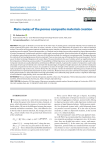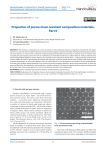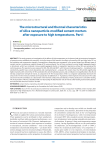International experience. Рубрика в журнале - Nanotechnologies in Construction: A Scientific Internet-Journal

Main routes of the porous composite materials creation
Статья научная
This paper is devoted to an overview of the main ways of creating porous composite materials. Porous materials are solids containing free space in the form of cavities, channels, or pores, which determine the presence of an internal interfacial surface. The analysis of the general methods of obtaining porous materials. A deposition is one of the most common methods for producing porous materials. Thermal decomposition, as a method used to obtain porous oxide materials by thermal decomposition of various compounds. Hydrothermal synthesis is widely used to produce zeolites. Selective dissolution of individual components of a substance using chemical reactions is also one of the effective methods for creating or increasing porosity. The paper discusses the methods of forming highly porous refractory materials. There are two main ways of forming refractory ceramic products. The first way is the direct sintering of dispersions of ceramic fibers. The second method is the use of a binder, which can significantly reduce the temperature of obtaining a porous product. The possibilities of obtaining porous nanocomposites based on aerogels are shown. Composite materials are usually obtained by combining two different materials. In general, the creation of composites is used to take advantage of each type of material and to minimize their disadvantages. Aerogels are fragile substances. But with the introduction of another component into their structure, it is possible to increase the strength of the material. Such materials have the desired optical properties, high surface area, and low density like silica aerogel. A review of methods for obtaining porous materials using the phenomenon of spinodal decomposition has been carried out. Materials whose structure is formed in microphase separation during polymerization or polycondensation have high permeability and a sufficiently large specific surface. A significant advantage of such materials is high porosity, which can reach 80% or more.
Бесплатно

Properties of porous heat-resistant composition materials. Part I
Статья научная
This article is a continuation of a series of articles on the production of porous composite nanomaterials. This paper presents an overview of the properties of porous, heat-resistant inorganic composite materials. The physicochemical and mechanical characteristics of various porous refractory materials produced industrially are presented. A separate class of materials with a regular and quasi-regular porous structure is considered. Such materials include the so-called cellular or «lattice» materials, that are becoming widely applied in modern industry. An example of such materials is ceramic foam – a sintered ceramic material with a foamy cellular structure. A special group of materials with opal pore structure has been also focused. Synthetic opals have received intensive development in recent years because they are model objects for the development and research of new spatial-periodic structures with nonlinear optical properties. Such structures include composites based on classical and inverted opals, in which the pores are filled with various dielectric, semiconductor, or metallic substances. The optical properties of these systems are determined by the size of the close-packed particles, as well as the dielectric constant of the components.
Бесплатно

Properties of porous heat-resistant composition materials. Part II
Статья научная
This article is a continuation of a series of articles on the production of porous composite nanomaterials. This paper presents an overview of the properties of porous, heat-resistant inorganic composite materials. The physicochemical and mechanical characteristics of various porous refractory materials produced industrially are presented. A separate class of materials with a regular and quasi-regular porous structure is considered. Such materials include the so-called cellular or «lattice» materials, that are becoming widely applied in modern industry. An example of such materials is ceramic foam – a sintered ceramic material with a foamy cellular structure. A special group of materials with opal pore structure has been also focused. Synthetic opals have received intensive development in recent years because they are model objects for the development and research of new spatial-periodic structures with nonlinear optical properties. Such structures include composites based on classical and inverted opals, in which the pores are filled with various dielectric, semiconductor, or metallic substances. The optical properties of these systems are determined by the size of the close-packed particles, as well as the dielectric constant of the components.
Бесплатно

Статья научная
This study presents an investigation of the effects of high temperature on the thermal and microstructural properties of cement mortars modified with nanosilica. In the first stage of the research, the effects of nanosilica (NS) and silica fume (SF) on the hydration and compressive strength of cementitious composites were compared. In the second stage, four different types of cement mortars, containing an optimal dosage of NS, were produced. Two of them contained a normal weight aggregate (quartz or limestone), whilst two contained a heavy weight aggregate (barite or magnetite). Specimens without NS were produced for control purposes. The specimens were exposed to 300, 450, 600 and 800°C, with their post-heating properties – including thermal conductivity, specific heat, solvent absorption and cracking behavior – analyzed. The results show that NS exhibits significantly higher reactivity with cement than SF. NS accelerates the cement hydration process and contributes more significantly to the 28 and 365 day compressive strength of mortar, as compared to SF. The incorporation of NS in a composite substantially decreases the amount of CH in the mixture and leads to the production of additional C–S–H gel phase, which improves microstructure. The study also shows that NS contributes to a decrement in the thermal conductivity and density of mortar, both prior to and after heating. The incorporation of NS has a beneficial effect on decreasing the deterioration rate of mortars after heating, by decreasing absorption rate and the amount of cracks in in them.
Бесплатно

Статья научная
This study presents an investigation of the effects of high temperature on the thermal and microstructural properties of cement mortars modified with nanosilica. In the first stage of the research, the effects of nanosilica (NS) and silica fume (SF) on the hydration and compressive strength of cementitious composites were compared. In the second stage, four different types of cement mortars, containing an optimal dosage of NS, were produced. Two of them contained a normal weight aggregate (quartz or limestone), whilst two contained a heavy weight aggregate (barite or magnetite). Specimens without NS were produced for control purposes. The specimens were exposed to 300, 450, 600 and 800°C, with their post-heating properties – including thermal conductivity, specific heat, solvent absorption and cracking behavior – analyzed. The results show that NS exhibits significantly higher reactivity with cement than SF. NS accelerates the cement hydration process and contributes more significantly to the 28 and 365 day compressive strength of mortar, as compared to SF. The incorporation of NS in a composite substantially decreases the amount of CH in the mixture and leads to the production of additional C–S–H gel phase, which improves microstructure. The study also shows that NS contributes to a decrement in the thermal conductivity and density of mortar, both prior to and after heating. The incorporation of NS has a beneficial effect on decreasing the deterioration rate of mortars after heating, by decreasing absorption rate and the amount of cracks in in them.
Бесплатно

